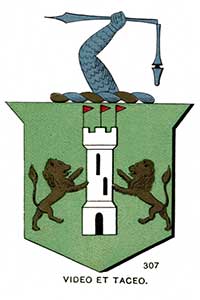The O’Shaughnessy or O’Shannesy Family

(Crest No. 307. Plate 24.)
THE O’Shaughnessy, Shaughnesy, O’Shannesy, or Shanesy family, as the name is variously spelled, is descended from Milesius, King of Spain, through the line of his son Heremon. The founder of the family was Fiachra, son of Eocha Moy Veagon, King of Ireland, A. D. 350. The ancient name was Sianaidhe, signifying “Crier” or “Pursuivant,” and was taken from Seachnasach Chief, A. D. 1100.
The O’Shaughnessys were of the same descent as the O’Heynes, and were chiefs of Kinel-Aedha, sometimes called Kinel Aedha-na-h-Echtege, or Kinel Hugh of Echty, a mountainous district on the borders of Galway and Clare. Kinel Hugh was a large district in the barony of Kiltartan, in the present County of Galway. O’Cathail, or O’Cahil, of the race of Hy Fiachra, was also a chief of Kinel Hugh.
The O’Shaughnessys, under King Roderick O’Connor, were among the first to offer armed resistance to the Anglo-Normans, and were always noted for their bravery and patriotism in opposing the invader.
The family espoused the cause of King James the Second, and forfeited their lands in consequence, after the failure of that irresolute monarch.
William O’Shaughnessy, son of Roger O’Shaughnessy and Helen, daughter of Conor MacDonogh O’Brien, Esq., of Ballynue, went to France with the first Irish Brigade under Lord Mountcashel, where he died in 1744, after having attained the rank of Major-General. He was the representative of the chiefs of the O’Shaughnessys.
The principal residence of the family was at Gort; and it was celebrated far and wide for its munificence, hospitality, and liberality. A writer, in the time of Charles the First, who traveled through Ireland and the Continent, declared that “the O’Shaughnessys then excelled, in elegant hospitality, all the nobility of Connaught, with the sole exception of the Marquis of Clanricard.”
The estates of the O’Shaughnessys were given by William the Third to Sir Thomas Prendergast, a man whose character is drawn in the blackest colors by Dean Swift. The rightful heir to the chieftainship and lands of the sept, William O’Shaughnessy, was then in France, where he remained until his death.
This last representative of the old clan of O’Shaughnessy was a notable character, and in every way worthy of his race and name. At the age of fifteen he was serving as Captain of a company of a hundred men in the war of the Revolution of 1688, in Ireland; and in 1690 he went to France in O’Brien’s, afterward Clare’s Regiment. The following year King Louis the Fourteenth commissioned him as Captain in that command. The remainder of his life was passed in military service all over the Continent. He participated in the following battles and sieges, and signalized himself repeatedly by his skill and bravery: Montmelian, Marsaglia, Valenza, Kehl, Munderkingen, Hochstedt, Blenheim, Ramillies, Oudenarde, Malplaquet, Arleux, Denain, Douay, Quesnoy, Bouchain, Landau, Friburgh, Etlingen, Philipsburgh, and Clausen. He died while in command at Gravelines, in the seventieth year of his age.
In statesmanship and literature the name of O’Shaughnessy has also attained distinction. Sir John O’Shannassy, Prime Minister of Victoria, Australia, and the greatest of Australian statesmen, was a scion of this ancient family; as was also the late Arthur O’Shaughnessy, one of the most meritorious of our latter day poets and writers. There are several of this name in the United States prominent in business and professional circles.
